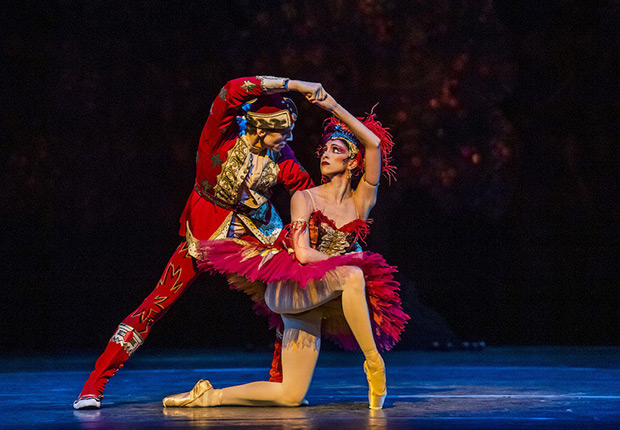
© Tristram Kenton, courtesy the Royal Opera House. (Click image for larger version)
Royal Ballet
The Firebird, A Month in the Country, Symphony in C
★★★★✰
London, Royal Opera House
4 June 2019
www.roh.org.uk
Three short but densely packed ballets infused with a strong Russian flavour were at the heart of the Royal Ballet’s last bill of the season. Classical works from three 20th century choreographers: Mikhail Fokine’s The Firebird, Frederick Ashton’s A Month in the Country and George Balanchine’s Symphony in C. Each feel like full-length ballets because of their setting is big, significant music scores by Stravinsky, Chopin and Bizet and in the case of the first two, elaborate stage and costume designs. In Firebird we are privileged to see the set and costumes designs of Natalia Goncharova, avant-garde artist with the Ballet Russes: the stunning red-fruited trees – habitat to the exotic bird, the enchanted forest and the Tsar’s dome-roofed kingdom at the end. While Julia Trevelyan Oman’s spectacular decor for A Month in the Country suggests all the trappings of a wealthy Russian country house in summer circa the 1840’s. The opulence of the programme as a whole together with dazzling performances by so many of the RB dancers, and musicians, whisks us away from the austerity and misery of our real world outside the ROH. Which is just as well as it is a very long evening.
My favourite, The Firebird, doesn’t disappoint with Yasmine Naghdi’s debut as the fascinating, bird-woman. She effectively embodies the arrogant yet vulnerable essence of the magical, flaming red bird, flighty yet assertive as she commands the enchanted creatures of the forest as well as Edward Watson’s Ivan Tsarevich. Naghdi’s presence is a calmly mesmerizing one, she’s less fluttery and agitated than some other Firebirds that I’ve seen and Watson looks rather flat besdie her as does Christina Arestis as the beautiful but dull Tsarevna. Their roles look altogether more rustic and plodding than Naghdi’s highly articulate and refined one.
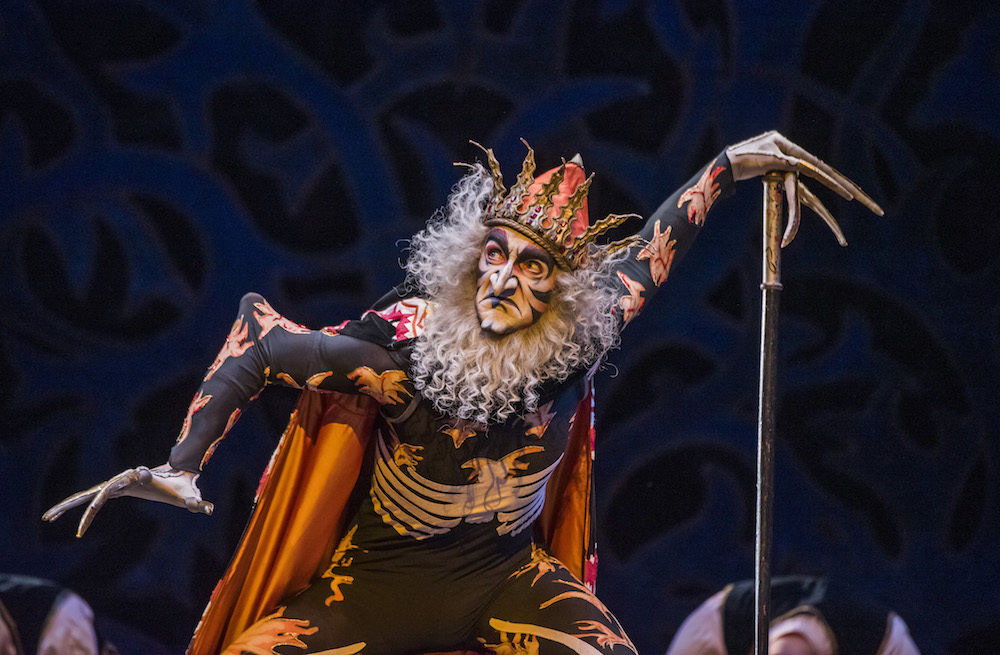
© Tristram Kenton, courtesy the Royal Opera House. (Click image for larger version)
Part of the charm of Firebird is the Russian mime and folk dance which replaces conventional ballet steps and because there is so much mimed action performed by various groups of the company, at times the principals seem to be doing very little apart from standing observing. It’s fabulous to see wave after wave of extraordinary characters flood on stage in outlandish dress – a cross section of people from Russian folklore, deities, monsters, enchanted princesses – none of whom would look out of place on a Star Wars’ set.
Out of all three ballets, the character of the Firebird offers the most commanding and progressive role for women; she doesn’t become entangled in love which usually equates to passive and wilting behaviour in the eyes of male choreographers; she’s an independent being, a seductive yet unattainable hybrid; her movement is more sophisticated and noticeable than the others as she’s the only women dancing en pointe; her unnervingly alert presence is utterly commanding although she’s never on stage very long. In comparison to Ashton’s and Balanchine’s roles for women in the bill, the Firebird speaks most to the modern woman.
The ballet is so impressively imaginative that it couldn’t help but delight the most cynical of spectators. Although as the choreography integrates with Stravinsky’s distinctive music, decor and theatricality creating a work of Wagnerian ‘total theatre’, it may frustrate dance purists. Which is why Symphony in C provides an appropriate coda to the evening. Following the indulgent, poignancy of A Month in the Country and the extravagant fantasy of Firebird, Symphony in C is formal, abstract and minimal. An intense blue wash on the back cyclorama frames the dancers in sharp relief in their pristine white, perky tutus. Against a stellar line-up of the corps, several principles enact contrasting pas de deux and solos. Consequently the ballet showcases an array of RB principles and soloists and it’s exciting to see so many on stage at the same time: Cesar Corrales, Sarah Lamb, Melissa Hamilton, Claire Calvert and Luca Acri to name a few. While some audience members may be disappointed by the absence of Natalia Osipova (due to injury) in the first movement, Fumi Kaneko steps in with a feisty vitality that is great to watch.

© Tristram Kenton, courtesy the Royal Opera House. (Click image for larger version)
Different groups of dancers and soloists appear and disappear across the four movements of Bizet’s symphony and the choreography seems to embrace the music. Not merely following it but working against it in counterpoint, cutting through it and mirroring it with repetition of steps and fragmentation by larger moves. By Bizet’s fast and furious fourth movement, the six soloists join large numbers of the corps to fill the stage and their combined force, as they execute tricky, quirky steps, rapid changes of direction and bold leg extensions is formidable to witness. Humans morph into machines of technical prowess and the labour of their exertions is visible on the faces of even these thoroughbred dancers. I’m exhausted just watching but fascinated about how clunky and awkward some of the footwork and body positions look . It’s as if Balanchine was experimenting with how much material he could fit into the music.
Separating the Slavic fantasy ballet and the sophisticated technical rigor of Symphony sits A Month in the Country which colours the stage with mood and atmosphere in its portrayal of difficult love and fractured human relationships. Ashton adapted Ivan Turgenev’s full-length play to a short ballet which focussed more on conveying the delicate shades of emotion and sensibility of its characters more than the narrative itself. Julia Trevelyan Oman’s languid setting, with sun pouring into an elegant sitting room, becomes both a playroom and a stifling prison for the protagonists. Ashton’s expressive choreography embellished by tricksy footwork and lilting upper body movements, leans and tilts explores a full palette of contrasting dynamics.

© Tristram Kenton, courtesy the Royal Opera House. (Click image for larger version)
The bored wife Natalia Petrovna, danced by Marianela Nunez finds passionate distraction in her son’s ravishing tutor, Beliaev (Matthew Ball). Irritable and tense without him, she’s floppy with desire when they’re together, abandoning her limp body to his admiring clutches. In a repetitive erotic gesture she throws her head back inviting Ball to lay his head on her breast. Ball’s strangely subdued movement, which hints at the end of their impulsive relationship, contrasts with the impetuous and fiery dancing of his lover’s ward Vera, outstandingly portrayed by Francesca Hayward. Notable too is James Hay as the energetic young son, Kolia whose athletic solo of youthful macho bravado, sends gasps round the audience. Principal character artist Gary Avis excels as Petrovna’s ambiguous and disappointed older admirer Rakitin.
As Petrovna and the men in her life become increasingly unhappy, it is the younger members of the family and the delightfully cheeky maid (Romany Pajdak) who remain the winners, free spirits outside the tangled web of love. While the ballet’s progressive roller-coaster of sentiments grips us it is Chopin’s final piano solo, Andante Spinato played by Kate Shipway that carries us away even further.












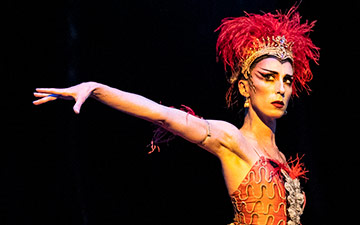
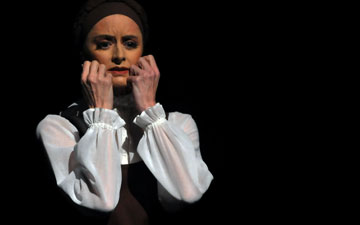

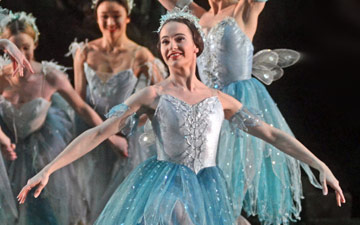
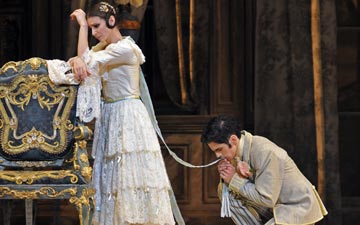
You must be logged in to post a comment.